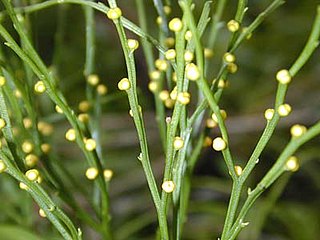
The ferns are a group of vascular plants that reproduce via spores and have neither seeds nor flowers. They differ from mosses by being vascular, i.e., having specialized tissues that conduct water and nutrients, and in having life cycles in which the branched sporophyte is the dominant phase.

Lycopodiopsida is a class of vascular plants also known as lycopods or lycophytes. Members of the class are also called clubmosses, firmosses, spikemosses and quillworts. They have dichotomously branching stems bearing simple leaves called microphylls and reproduce by means of spores borne in sporangia on the sides of the stems at the bases of the leaves. Although living species are small, during the Carboniferous, extinct tree-like forms (Lepidodendrales) formed huge forests that dominated the landscape and contributed to coal deposits.

Equisetum is the only living genus in Equisetaceae, a family of vascular plants that reproduce by spores rather than seeds.

Osmundaceae is a family of ferns containing four to six extant genera and 18–25 known species. It is the only living family of the order Osmundales in the class Polypodiopsida (ferns) or in some classifications the only order in the class Osmundopsida. This is an ancient and fairly isolated group that is often known as the "flowering ferns" because of the striking aspect of the ripe sporangia in Claytosmunda, Osmunda, Osmundastrum, and Plensium. In these genera the sporangia are borne naked on non-laminar pinnules, while Todea and Leptopteris bear sporangia naked on laminar pinnules. Ferns in this family are larger than most other ferns.
In plant anatomy and evolution a microphyll is a type of plant leaf with one single, unbranched leaf vein. Plants with microphyll leaves occur early in the fossil record, and few such plants exist today. In the classical concept of a microphyll, the leaf vein emerges from the protostele without leaving a leaf gap. Leaf gaps are small areas above the node of some leaves where there is no vascular tissue, as it has all been diverted to the leaf. Megaphylls, in contrast, have multiple veins within the leaf and leaf gaps above them in the stem.

Equisetaceae, also known as the horsetail family, is a family of ferns and the only surviving family of the order Equisetales, with one surviving genus, Equisetum, comprising about twenty species.

Equisetales is an order of subclass Equisetidae with only one living family, Equisetaceae, containing the genus Equisetum (horsetails), as well as a variety of extinct groups, including the tree-like Calamitaceae.
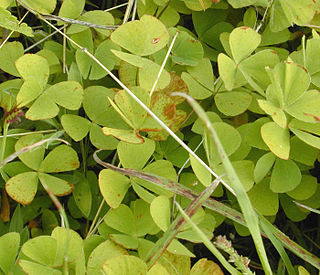
The order Salviniales is an order of ferns in the class Polypodiopsida.

Gleicheniales is an order of ferns in the subclass Polypodiidae. The Gleicheniales have records potentially as early as the Carboniferous, but the oldest unambiguous records date to the Permian.

The order Cyatheales, which includes most tree ferns, is a taxonomic order of the fern class, Polypodiopsida. No clear morphological features characterize all of the Cyatheales, but DNA sequence data indicate the order is monophyletic. Some species in the Cyatheales have tree-like growth forms from a vertical rhizome, others have shorter or horizontal expanding rhizomes.
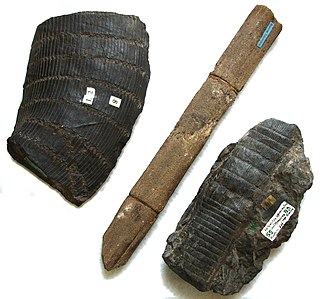
Calamites is a genus of extinct arborescent (tree-like) horsetails to which the modern horsetails are closely related. Unlike their herbaceous modern cousins, these plants were medium-sized trees, growing to heights of 30–50 meters. They were components of the understories of coal swamps of the Carboniferous Period.

A pteridophyte is a vascular plant that reproduces by means of spores. Because pteridophytes produce neither flowers nor seeds, they are sometimes referred to as "cryptogams", meaning that their means of reproduction is hidden.

Psilotaceae is a family of ferns consisting of two genera, Psilotum and Tmesipteris with about a dozen species. It is the only family in the order Psilotales.
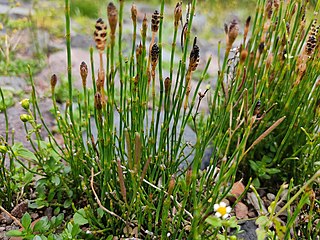
Equisetum bogotense, the Andean horsetail, is a herbaceous perennial that reproduces through spores. It has thicker, less bushy whorled branches, and a silica rich rhizomatous stem, which roots grow out of, under ground. This stem is a dull dark brown color with glabrous growth aside from the sheathed segments. The plant has a history as a traditional herbal remedy, and a study of its diuretic effects on humans showed significant increases in urinary sodium, potassium, and chloride. Human and animal trials of indicate that E. bogotense has "high" efficacy as a diuretic. It is used in several modern herbal supplements. The species epithet refers to Bogotá, the capital of Colombia.

Eusporangiate ferns are vascular spore plants, whose sporangia arise from several epidermal cells and not from a single cell as in leptosporangiate ferns. Typically these ferns have reduced root systems and sporangia that produce large amounts of spores.
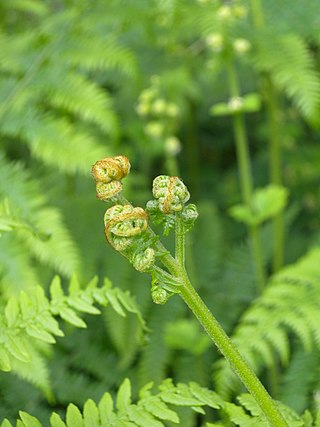
The Polypodiidae, commonly called leptosporangiate ferns, formerly Leptosporangiatae, are one of four subclasses of ferns, the largest of these being the largest group of living ferns, including some 11,000 species worldwide. The group has also been treated as the class Pteridopsida or Polypodiopsida, although other classifications assign them a different rank. Older names for the group include Filicidae and Filicales, although at least the "water ferns" were then treated separately.

Equisetum palustre, the marsh horsetail, is a perennial herbaceous pteridophyte belonging to the subclass of horsetails (Equisetidae). It is widespread in cooler regions of Eurasia and North America.

Fern allies are a diverse group of seedless vascular plants that are not true ferns. Like ferns, a fern ally disperses by shedding spores to initiate an alternation of generations.
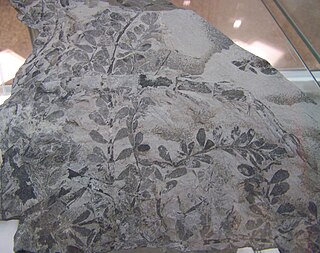
Sphenophyllales is an extinct order of articulate land plants and a sister group to the present-day Equisetales (horsetails). They are fossils dating from the Devonian to the Triassic. They were common during the Late Pennsylvanian to Early Permian, with most of the fossils coming from the Carboniferous period.

Ophioglossidae is one of the four subclasses of Polypodiopsida (ferns). This subclass consists of the ferns commonly known as whisk ferns, grape ferns, adder's-tongues and moonworts. It is equivalent to the class Psilotopsida in previous treatments, including Smith et al. (2006). The subclass contains two orders, Psilotales and Ophioglossales, whose relationship was only confirmed by molecular phylogenetic studies.




















